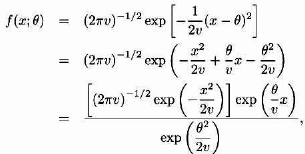5.4 The linear exponential family
A large parametric family that includes many of the distributions of interest to actuaries has special use in Bayesian analysis (Section 15.3) and in credibility (Section 18.7). The definition is as follows.
Definition 5.9 A random variable X (discrete or continuous) has a distribution from the linear exponential family if its pdf may be parameterized in terms of a parameter θ and expressed as
The function p(x) depends only on x (not on θ), and the function q(θ) is a normalizing constant. Also, the support of the random variable must not depend on θ. The parameter r(θ) is called the canonical parameter of the distribution.
Many standard distributions are of this form as shown in the following examples.
 EXAMPLE 5.11
EXAMPLE 5.11
Show that the normal distribution is a member of the linear exponential family.
The pdf is, letting the mean be θ,

which is of the form (5.6). with p(x) = (2πv)−1/2 exp[-x2/(2v)], r(θ) = θ/v, and q(θ) = exp[θ2/(2v)].
 EXAMPLE 5.12
EXAMPLE 5.12
Show that the gamma distribution is a member of the linear exponential family.
The pdf is (from Appendix ...
Get Loss Models: From Data to Decisions, 4th Edition now with the O’Reilly learning platform.
O’Reilly members experience books, live events, courses curated by job role, and more from O’Reilly and nearly 200 top publishers.

